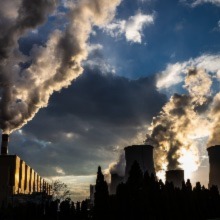Researchers engineer synthetic microbial communities to clean up industrial waste streams
24 May 2022

Researchers at the University of Sheffield, UK, have created acclimatised communities of environmental bacteria and algae that can biodegrade toxic organic chemicals in industrial waste streams.
Many industrial processes produce volatile organic compounds (VOCs), which pollute the surrounding environment and can be harmful to human health, causing breathing difficulties as well as irritation to the eyes, nose and throat. Scientists are interested in using biological organisms to break down and detoxify VOCs. This process is known as ‘bioremediation’. “For the removal of VOCs, we know there are some chemical or physical methods, but these can be costly and unsustainable,” said Zongting Cai, a PhD student at the University of Sheffield, “Bioremediation is driven by natural processes and therefore has less of an impact on ecosystems,” he explained.
Zongting is working with UK-based topsoil supplier Freeland Horticulture Limited to design a method of removing manmade VOC contamination in urban air, which is generated by combustion processes, using natural communities of acclimatised environmental microbes. More information on Freeland Horticulture Limited is available on their website. Specifically, the aim of the research was to identify naturally occurring microbes that may be able to break down aromatic VOCs, which are typical pollutants in combustion gases.
“Bacteria are the core of many bioremediation processes, but most of them are heterotrophic, meaning they need feeding with a carbon source to survive, which could bring extra costs,” said Zongting. “But in my research project, I combine heterotrophic bacteria with a photosynthetic partner, the microalgae, just like in the natural world where microalgae and bacteria usually co-exist.” This means microalgae can make their own food using energy from the sun and carbon dioxide in the air.
Zongting began by collecting microbe samples from a petrol station, where VOCs in petroleum products had polluted the surrounding area. In theory, the microbes should have adapted to the pollution over time and become resistant to VOCs. Zongting isolated strains of bacteria and microalgae from the samples and grew them together in a culture alongside VOCs, but without any additional carbon source. He developed a method to screen thousands of microbe combinations and identified some candidate communities with the best traits to develop a low-cost, self-sustaining system.
Zongting found that some bacterial strains are able to use VOCs as their sole carbon source. Not only that, but the VOC-resistant bacteria also promoted the growth of microalgae by providing carbon dioxide to use in photosynthesis. “Those cultures that managed to grow have a really strong ability to break down VOCs, utilise VOCs for carbon and metabolically convert them into carbon dioxide, which then is used as part of algal photosynthesis,” Zongting explained.
This forms part of a wider project to work out which combinations of microbes can most efficiently break down VOCs, while simultaneously maximising production of algae biomass to use as an industrial resource. Ultimately, these carefully selected microbial communities could be scaled up for use in a bioreactor to clean up industrial air emissions with low concentrations of organic contamination.
“In any environment, the local microbes have a strong ability to do tough biological tasks, like breaking down pollutants. But the natural system doesn’t always come in a perfect way,” said Zongting, “As scientists, I think it’s our job to develop a method to refine these abilities to engineer solutions to environmental problems.”
Zongting Cai will present these findings at the Microbiology Society’s Focused Meeting, Microbial Cycling of Volatile Organic Compounds: Biogeochemistry to Biotechnology. His talk, titled ‘Bottom-up design of synthetic algae-bacteria consortia for VOCs degradation and conversion into resource’, will take place at 16:30 on Wednesday 25 May 2022.
Image: iStock/FOTOFORCE.
